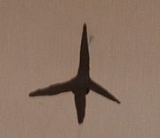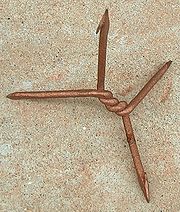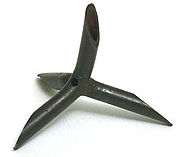
Caltrop
Encyclopedia

Tetrahedron
In geometry, a tetrahedron is a polyhedron composed of four triangular faces, three of which meet at each vertex. A regular tetrahedron is one in which the four triangles are regular, or "equilateral", and is one of the Platonic solids...
). They may be thought of as the landmines of antiquity, useful to shape the battlefield and force the enemy into certain paths and approaches, or to provide a passive defense as part of a defensive works system. Caltrops served to slow down the advance of horse
Horse
The horse is one of two extant subspecies of Equus ferus, or the wild horse. It is a single-hooved mammal belonging to the taxonomic family Equidae. The horse has evolved over the past 45 to 55 million years from a small multi-toed creature into the large, single-toed animal of today...
s, war elephant
War elephant
A war elephant was an elephant trained and guided by humans for combat. Their main use was to charge the enemy, trampling them and breaking their ranks. A division of war elephants is known as elephantry....
s, and human troops. They were said to be particularly effective against the soft feet of camel
Camel
A camel is an even-toed ungulate within the genus Camelus, bearing distinctive fatty deposits known as humps on its back. There are two species of camels: the dromedary or Arabian camel has a single hump, and the bactrian has two humps. Dromedaries are native to the dry desert areas of West Asia,...
s. In more modern times, caltrops are used against wheeled vehicles with pneumatic tire
Tire
A tire or tyre is a ring-shaped covering that fits around a wheel rim to protect it and enable better vehicle performance by providing a flexible cushion that absorbs shock while keeping the wheel in close contact with the ground...
s.
The modern name "caltrop" is derived from the Latin calcitrapa (foot-trap). The synonymous Latin word tribulus
Tribulus
Tribulus is a genus of plants found in many warm regions. The best-known member is T. terrestris , a widespread weed and also the source of a dietary supplement....
gave rise to the modern Latin name of a plant offering similar hazards to sandaled or bare feet, Tribulus terrestris
Tribulus terrestris
Tribulus terrestris is a flowering plant in the family Zygophyllaceae, native to warm temperate and tropical regions of the Old World in southern Europe, southern Asia, throughout Africa, and Australia. It can thrive even in desert climates and poor soil...
(Zygophyllaceae
Zygophyllaceae
The Zygophyllaceae is a family of flowering plants that contains the bean-caper and caltrop. It includes around 285 species in 22 genera.In the APG III system of classification, the families Zygophyllaceae and Krameriaceae compose the order Zygophyllales...
), whose spiked seed case can also injure feet and puncture tires. This plant can also be compared to the starthistle Centaurea calcitrapa
Centaurea calcitrapa
Centaurea calcitrapa is a species of flowering plant known by several common names, including purple starthistle and red starthistle. It is native to Europe but is rarely found there, it is known across the globe as an introduced species and often a noxious weed...
, which is sometimes called the "caltrop". A water plant with similarly-shaped spiked seeds is called the "water caltrop
Water caltrop
The water caltrop, water chestnut, buffalo nut, bat nut, devil pod or Singhara or Pani-fol is either of two species of the genus Trapa: Trapa natans and Trapa bicornis...
", Trapa natans.
History
Iron caltrops were used as early as 331 BC at Gaugamela according to Quintus Curtius (IV.13.36). They were known to the Romans as tribulus or sometimes as Murex ferreus, the latter meaning 'jagged iron'.They were used in the Battle of Carrhae
Battle of Carrhae
The Battle of Carrhae, fought in 53 BC near the town of Carrhae, was a major battle between the Parthian Empire and the Roman Republic. The Parthian Spahbod Surena decisively defeated a Roman invasion force led by Marcus Licinius Crassus...
in 51 BC.
The late Roman
Ancient Rome
Ancient Rome was a thriving civilization that grew on the Italian Peninsula as early as the 8th century BC. Located along the Mediterranean Sea and centered on the city of Rome, it expanded to one of the largest empires in the ancient world....
writer Vegetius
Vegetius
Publius Flavius Vegetius Renatus, commonly referred to simply as Vegetius, was a writer of the Later Roman Empire. Nothing is known of his life or station beyond what he tells us in his two surviving works: Epitoma rei militaris , and the lesser-known Digesta Artis Mulomedicinae, a guide to...
, referring in his work De Re Militari
De Re Militari
De Re Militari , also Epitoma Rei Militaris, is a treatise by the late Latin writer Vegetius about Roman warfare and military principles as a presentation of methods and practices in use during the height of Rome's power, and responsible for that power...
to scythed chariot
Scythed chariot
The scythed chariot was a war chariot with scythe-like blades mounted on each side, employed in ancient times.-History:The scythed chariot was a modified war chariot. The blades extended horizontally for about to each side of the wheels...
s, wrote:
The caltrop continued in use into the 17th century; a single example was found in Jamestown, Virginia
Jamestown, Virginia
Jamestown was a settlement in the Colony of Virginia. Established by the Virginia Company of London as "James Fort" on May 14, 1607 , it was the first permanent English settlement in what is now the United States, following several earlier failed attempts, including the Lost Colony of Roanoke...
, in the United States
United States
The United States of America is a federal constitutional republic comprising fifty states and a federal district...
.
The Japanese version of the caltrop is called makibishi
Makibishi
The term makibishi refers to the Japanese version of the caltrop.-Description:Makibishi , sharp spiked objects that were used in feudal Japan to slow down pursuers and also were used in the defense of samurai fortifications.Makibashi were one of the items supposedly used by ninja...
. Makibishi were sharp spiked objects that were used in feudal Japan to slow down pursuers and also were used in the defense of samurai fortifications. Iron makibishi were called tetsubishi while the makibishi made from the dried seed pod of the water chestnut formed a natural type of makibashi called tennenbishi. Both types of makibishi could penetrate the thin soles of the shoes such as the waraji
Waraji
Waraji are sandals made from straw rope that in the past were the standard footwear of the common people in Japan. Waraji were also worn by the samurai class and foot soldiers during the feudal era of Japan.-Description:...
sandals that were commonly worn in feudal Japan.
Caltrop-like devices
Punji stickPunji stick
The Punji stick or Punji stake is a type of booby trapped stake. It is a simple spike, made out of wood or bamboo, generally placed upright in the ground. Punji sticks are usually deployed in substantial numbers....
s perform a similar role to caltrops. These are sharpened sticks placed vertically in the ground. Their use in modern times targets the body and limbs of a falling victim rather than well-shod feet, by means of a pit or tripwire.
In Britain
United Kingdom
The United Kingdom of Great Britain and Northern IrelandIn the United Kingdom and Dependencies, other languages have been officially recognised as legitimate autochthonous languages under the European Charter for Regional or Minority Languages...
, during the Second World War, large caltrop shaped objects made from reinforced concrete
Reinforced concrete
Reinforced concrete is concrete in which reinforcement bars , reinforcement grids, plates or fibers have been incorporated to strengthen the concrete in tension. It was invented by French gardener Joseph Monier in 1849 and patented in 1867. The term Ferro Concrete refers only to concrete that is...
were used as anti-tank devices, although it seems that these were rare. Very much more common were concrete devices called dragon's teeth
Dragon's teeth (fortification)
Dragon's teeth are square-pyramidal fortifications of reinforced concrete first used during the Second World War to impede the movement of tanks and mechanised infantry...
that were designed to wedge into tank
Tank
A tank is a tracked, armoured fighting vehicle designed for front-line combat which combines operational mobility, tactical offensive, and defensive capabilities...
treads, and large ones weighing over 1 tonne are still used by the army to deny access to wheeled vehicles, especially in camp areas. However, dragon's teeth are immobile, so the analogy with the caltrop is inexact, but caltrop-like concrete blocks that interlock when piled up are used in the construction of sea defences. Another caltrop-like WWII defence is the massive, steel, freestanding Czech hedgehog
Czech hedgehog
The Czech hedgehog or ježek, was a static anti-tank obstacle defence made of angled iron deployed during World War II by various combatants....
s that were designed as anti-tank obstacles and were also used to damage warship
Warship
A warship is a ship that is built and primarily intended for combat. Warships are usually built in a completely different way from merchant ships. As well as being armed, warships are designed to withstand damage and are usually faster and more maneuvrable than merchant ships...
s and landing craft
Landing craft
Landing craft are boats and seagoing vessels used to convey a landing force from the sea to the shore during an amphibious assault. Most renowned are those used to storm the beaches of Normandy, the Mediterranean, and many Pacific islands during WWII...
. These were in heavy use at Normandy and other beach-conflicts.
Tire deflation device

Australian Light Horse troops
Caltrops were collected by Australian Light Horse troops as keepsakes. These Caltrops were either made by welding two pieces of wire together to form a four pointed star or pouring molten steel into a mould to form a solid, seven pointed star. The purpose of these devices was to disable horses. They were exchanged with French troops for bullets. The Australian Light Horse troops referred to them as "Horse Chestnuts". Examples from 1917 are kept in the Cart Museum in Bundeena, situated in the state of Victoria, Australia.Labor activists
Caltrops have been used at times during labor strikes and other disputes. Such devices were used by some to destroy the tires of management and replacement workers. In this context, caltrops are usually referred to as "jack rocks," and have become an icon in pro-union rallies, often depicted on t-shirts, hats, or even worn as jewelry in some cases.Because of the prevalence of caltrops during the Caterpillar
Caterpillar Inc.
Caterpillar Inc. , also known as "CAT", designs, manufactures, markets and sells machinery and engines and sells financial products and insurance to customers via a worldwide dealer network. Caterpillar is the world's largest manufacturer of construction and mining equipment, diesel and natural gas...
strike of the mid-1990s, the state of Illinois passed a law making the possession of such devices a misdemeanor.
Symbolic use

Heraldry
Heraldry is the profession, study, or art of creating, granting, and blazoning arms and ruling on questions of rank or protocol, as exercised by an officer of arms. Heraldry comes from Anglo-Norman herald, from the Germanic compound harja-waldaz, "army commander"...
.
For example, the arms and standard of Clan Drummond
Clan Drummond
Clan Drummond is a Scottish clan deriving its name from the parish of Drymen, in what was western Stirlingshire. Legend gives Maurice of Hungary as founder of the clan...
include caltrops, memorializing their use in the Battle of Bannockburn
Battle of Bannockburn
The Battle of Bannockburn was a significant Scottish victory in the Wars of Scottish Independence...
.
The caltrop is the symbol of the US Army's III Corps, which is based at Fort Hood, Texas
Texas
Texas is the second largest U.S. state by both area and population, and the largest state by area in the contiguous United States.The name, based on the Caddo word "Tejas" meaning "friends" or "allies", was applied by the Spanish to the Caddo themselves and to the region of their settlement in...
. III Corps traces its lineage to the days of horse cavalry
Cavalry
Cavalry or horsemen were soldiers or warriors who fought mounted on horseback. Cavalry were historically the third oldest and the most mobile of the combat arms...
, which used the caltrop as an area denial weapon.
It is also the symbol of the United States Marine Corps
United States Marine Corps
The United States Marine Corps is a branch of the United States Armed Forces responsible for providing power projection from the sea, using the mobility of the United States Navy to deliver combined-arms task forces rapidly. It is one of seven uniformed services of the United States...
' 3rd Division, formed on September 16, 1942.
The Finnish noble family Fotangel (Swedish
Swedish language
Swedish is a North Germanic language, spoken by approximately 10 million people, predominantly in Sweden and parts of Finland, especially along its coast and on the Åland islands. It is largely mutually intelligible with Norwegian and Danish...
for 'caltrop') had arms Gules, three caltrops Argent.

